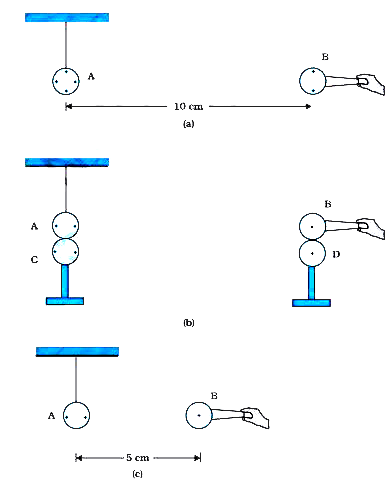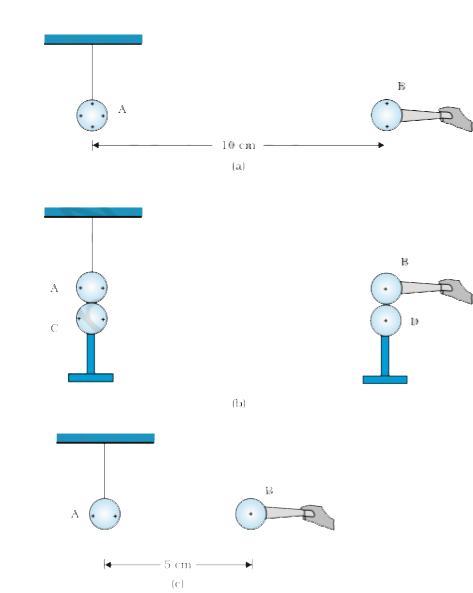A charged metallic spere A is suspended by a nylon thread another charged metallic spere b held by an insulating centres is 10 cm c and d are then removed and b is brought closer to a to a what is txpectd repulsion of a on the basis of columb law sphere a and c speres b and d have indentical sizes ignore the sizes of a and b in comparision to the separation between their centres

Let the original charge on spere a be q and that on b be q at a distance r beteen their centres the magnitude of the F=14πε0qqr2
neglecting the sizes of sperhers a and b in comparions to r when an identical but unchanged spere c touches a the charges redisitribute on a and c and by symmetry each sprere carries a charge q/2 similary after d touches b the rredistributed charge on each is of the electrosatic force on each is
F=14πε0(q/2)(q/2)(r/2)2=14πε0qqr2=F
Thus the electrostatic force on a due to b remains unaltered
Similar Questions
A charged metallic sphere A is suspended by a nylon thread. Another charged metallic sphere B held by an insulating handle is brought close to A such that the distance between their centres is 10 cm, as shown in Fig. 1.7(a). The resulting repulsion of A is noted (for example, by shining a beam of light and measuring the deflection of its shadow on a screen). Spheres A and B are touched by uncharged spheres C and D respectively, as shown in Fig. 1.7(b). C and D are then removed and B is brought closer to A to a distance of 5.0 cm between their centres, as shown in Fig. 1.7(c). What is the expected repulsion of A on the basis of Coulomb’s law? Spheres A and C and spheres B and D have identical sizes. Ignore the sizes of A and B in comparison to the separation between their centres.

View SolutionA charged metallic sphere A is suspended by a nylon thread. Another charged metallic sphere B held by an insulating handle is brought close to A such that the distance between their centres is 10 cm, as shown in Fig. 1.7(a). The resulting repulsion of A is noted (for example, by shining a beam of light and measuring the deflection of its shadow on a screen). Spheres A and B are touched by uncharged spheres C and D respectively, as shown in Fig. 1.7(b). C and D are then removed and B is brought closer to A to a distance of 5.0 cm between their centres, as shown in Fig. 1.7(c). What is the expected repulsion of A on the basis of Coulomb’s law? Spheres A and C and spheres B and D have identical sizes. Ignore the sizes of A and B in comparison to the separation between their centres.

View Solution
Knowledge Check
One metallic sphere A is given positive charge whereas another identical metallic sphere B of exactly same mass as of A is given equal amount of negative charge. Then
AMass of A and mass of B still remain equalBMass of A increasesCMass of B decreasesDMass of B increases
A charged metallic sphere A is suspended by a nylon thread. Another charged metallic sphere B held by an insulating handle is brought close to A such that the distance between their centres is 10 cm, as shown in Fig. 1.7(a). The resulting repulsion of A is noted (for example, by shining a beam of light and measuring the deflection of its shadow on a screen). Spheres A and B are touched by uncharged spheres C and D respectively, as shown in Fig. 1.7(b). C and D are then removed and B is brought closer to A to a distance of 5.0 cm between their centres, as shown in Fig. 1.7(c). What is the expected repulsion of A on the basis of Coulomb’s law? Spheres A and C and spheres B and D have identical sizes. Ignore the sizes of A and B in comparison to the separation between their centres.

View SolutionOne metallic sphere A is given positive charge whereas another identical metallic sphere B of exactly same mass as of A is given equal amount of negative charge. Then
View SolutionA metal sphere is suspended from a nylon thread. Initially, the metal sphere is uncharged. When a positively charged glass rod is brought close to the metal sphere, the sphere is drawn towards the rod. But if the sphere touches the rod, it suddenly flies away from the rod. Explain, why the sphere is first attracted then repelled?
View SolutionA metal sphere is suspended from a nylon thread. Initially, the metal sphere is uncharged. When a positively charged glass rod is brought close to the metal sphere, the sphere is drawn towards the rod. But if the sphere touches the rod, it suddenly flies away from the rod. Explain, why the sphere is first attracted then repelled?
View SolutionTwo indentical metallic spheres A and B, each carrying a charge q repel each other with a force F. A third metallic uncharged sphere C of the same size is made to touch the spheres A and B alternately and then removed away. What is the force of repulsion between A and B ?
View SolutionAn uncharged metal sphere suspended by a silk thread is placed in a uniform external electric field. E. (a) what is the magnitude of the electric field for points inside the sphere ? (b) is your answer changed if the sphere carriers a charge ?
View SolutionAn uncharged metal sphere suspended by a silk thread is placed in a uniform extermal electric field. E. (a) what is the magnitude of the electric field for points inside the sphere ? (b) is your answer changed if the sphere carriers a charge ?
View Solution
